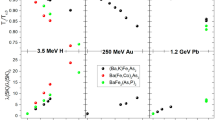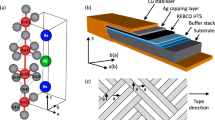Abstract
Many of the newly developed materials, such as rare-earth permanent magnets, amorphous alloys and oxide superconductors, have important applications in radiation environments. These environments can have various negative or beneficial effects on the properties, depending on the amount of radiation and the nature of material. Properties such as the critical current in superconductors can actually be increased by radiation, while critical temperature is decreased. More detailed study of the mechanisms responsible for such radiation-induced changes may lead to materials with greater stability in these challenging environments.
Similar content being viewed by others
References
M. Sagawa et al., “Permanent Magnet Materials Based on the Rare Earth-Iron-Boron Tetragonal Compounds,” IEEE Trans. Magn., MAG-20 (1984), pp. 1584–1589.
A. Menth, H. Nagel and R.S. Perkins, “New High-Performance Permanent Magnets Based on Rare Earth-Transition Metal Compounds,” Ann. Rev. Mater. Sci., 8 (1978), pp. 21–47.
M.K. Wu et al., “Superconductivity at 93 K in a New Mixed-Phase Y-Ba-Cu-O Compound System at Ambient Pressure,” Phys. Rev. Lett., 58 (1987), p. 908.
D.R. Olander, “Radiation Effects,” Fundamental Aspects of Nuclear Reactor Fuel Elements, ed, D.R. Olander (Tech. Info. Center, ERDA, 1976), pp. 373–417.
K. Halbach, “Design of Permanent Multipole Magnets with Oriented Rare Earth Cobalt Material,” Nucl. Instr. and Methods, 169 (1980), pp. 1–10.
E.W. Blackmore, “Radiation Effects of Protons on Samarium-Cobalt Permanent Magnets,” IEEE Trans. Nucl. Sci., NS-32 (1985), pp. 3669–3671.
J.R. Cost and R.D. Brown, “Radiation Effects in Rare-Earth Permanent Magnets,” High Performance Ferromagnetic Materials, ed. S.G. Sankar (Pittsburgh, PA: MRS, 1987), pp. 321–327.
J.R. Cost, R.D. Brown, A.L. Giorgi and J.T. Stanley, “Effects of Neutron Irradiation on Nd-Fe-B Magnetic Properties,” IEEE Trans. Magn., 24 (1988), pp. 2016–2019.
R.D. Brown and J.R. Cost, “Radiation-Induced Changes in Magnetic Properties of Nd-Fe-B Permanent Magnets,” IEEE Trans. Magn., 25 (1989), pp. 3117–3120.
J.R. Cost and R.D. Brown, “Sm-Co Permanent Magnets: Effects of Fast Neutron Irradiation,” Met. Trans., in press.
H. Spitzer and A. Weller, “Magnetisierungsverlust von Samarium-Kobalt Permanentmagneten in hohen Neutronfeldern,” Kemsforschungsanlage Jülich Report SNQ 1 N/BH 22/05/84, May 1984.
R.D. Brown, J.R. Cost and J.T. Stanley, “Effects of Neutron Irradiation on Magnetic Permeability of Amorphous and Crystalline Magnetic Alloys,” J. Appl. Phys., 55 (1984), pp. 1754–1756.
R.D. Brown, J.R. Cost and J.T. Stanley, “Irradiation-Induced Decay of Magnetic Permeability of MetGlas 2605S-3 and Mumetal,” J. Nucl. Mater., 131 (1985), pp. 37–43.
J.R. Cost, “Non-Linear Regression Analysis Method for Determining Relaxation Time Spectra for Processes with First-Order Kinetics,” J. Appl. Phys., 54 (1983), pp. 2137–2146.
A.I. Schindler, R.H. Kernohan and J. Weertman, “Effect of Irradiation on Magnetic Properties of Fe-Ni Alloys,” J. Appl. Phys., 35 (1964), p. 2640.
J.R. Cost, J.O. Willis, J.D. Thompson and D.E. Peterson, “Fast-Neutron Irradiation of YBa2Cu3Ox,” Phys. Rev., B 37 (1988), pp. 1563–1568.
J.O. Willis, et al., “Radiation Damage in YBa2Cu3Ox by Fast Neutrons,” Mat. Res. Soc. Symp. Proc., 99 (1988), pp. 391–394.
A. Umezawa et al., “Enhanced Critical Magnetization Currents Due to Fast Neutron Irradiation in Single-Crystal YBa2Cu3O7-δ,” Phys. Rev. B, 36 (1987), pp. 7151–7154.
ST. Sekula et al., “Fast Neutron Damage Studies of La1.85Sr0.15CuO4,” Jpn. J. Appl. Phys., 26 (1987), p. 1185.
H. Kupfer et al., “Fast Neutron Irradiation of YBa2Cu3O7,” Z. Phys. B, 69 (1987), p. 167.
J.O. Willis, et al., “Proton Radiation Damage in Superconducting EuBa2Cu3Ox and GdBa2Cu3Ox,” Appl. Phys. Lett., 53 (1988), pp. 417–419.
C.P. Bean, “Magnetization of Hard Superconductors,” Phys. Rev. Lett., 8 (1962), p. 250.
A.R. Sweedler, D.E. Cox and S. Moehlecke, “Neutron Irradiation of Superconducting Compounds,” J. Nucl. Mater., 72 (1978), pp. 50–69.
Author information
Authors and Affiliations
Rights and permissions
About this article
Cite this article
Brown, R.D., Cost, J.R. Radiation effects in magnetic and superconducting materials. JOM 42, 39–43 (1990). https://doi.org/10.1007/BF03220872
Issue Date:
DOI: https://doi.org/10.1007/BF03220872




